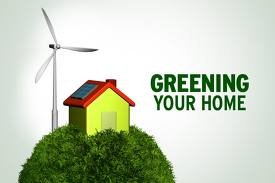Unexpected Ways to Save Money on Energy and Green Your Home!

Unexpected Ways to Save Money on Energy and Green Your Home
In today’s world, with environmental concerns and rising energy costs, finding ways to save money on energy while greening your home has never been more critical. The good news is that there are a lot of ways to achieve this goal — some of them innovative and unexpected.
Here are a few energy saving tips for changes you can make to make your home greener and save on your electricity bill.
- Switching to a laptop instead of using a desktop saves over 33% of energy.
- Keeping your freezer full uses less energy than an empty one. Don’t need all that extra food? Put containers of water in the freezer to take up the empty space and save energy consumption.
- Is estimated that 8% of the total energy used in our homes is for air conditioning. Cut back on your cooling costs by using ceiling fans. Ceiling fans use less or equal the electricity than a regular light bulb, and the wind from a fan can make you feel three or four degrees cooler. In the winter, turn fans on the clockwise setting on low speed to help push heat that rises down to your level.
- To make the room brighter with low watt light bulbs or lamps on dimmer switches, put lamps in the corners to mirror the light off the connecting walls. This will save energy without compromising your rooms brightness.
- Believe it or not, doing the dishes in the dishwasher instead of doing them by hand saves over 66% of hot water. Save energy by decreasing your water heater temperature to 130° F.
- Top off the savings by using a specially designed “blanket” that will hold the heat in your water heater. You can also use cold water to wash clothes and save $63 a year.
From simple changes in your daily habits to investing in energy-efficient technology, these strategies can help you reduce your carbon footprint and lower your utility bills.
More Ways to Save
In addition to the less-well-known changes listed above, there are many other ways to save money and make your home greener. Read on for more.
1. Install a Smart Thermostat
Investing in a smart thermostat is one of the most effective ways to manage your home’s energy consumption. Unlike traditional thermostats, smart thermostats learn your routine and adjust your home’s temperature accordingly.
Benefits:
- Energy Savings: Smart thermostats can save up to 10%-15% on heating and cooling costs.
- Remote Control: Most smart thermostats come with mobile apps, allowing you to control your home’s temperature from anywhere.
- Energy Reports: Receive detailed reports on your energy usage and get tips on how to save more.
2. Seal and Insulate Your Home
Proper insulation and sealing can drastically improve your home’s energy efficiency. By preventing drafts and keeping the warm or cool air inside, you will use less energy to maintain a comfortable temperature.
Benefits:
- Reduced Energy Bills: Proper insulation can cut heating and cooling costs by 20%.
- Increased Comfort: Eliminate drafts and cold spots in your home.
- Sustainable Living: Decreasing energy usage reduces greenhouse gas emissions.
3. Switch to LED Lighting
LED bulbs are more energy-efficient than traditional incandescent bulbs. They use up to 80% less energy and last 25 times longer.
Benefits:
- Lower Electricity Bills: Switching to LED can significantly reduce your lighting costs.
- Durability: LED bulbs have a longer lifespan.
- Environmental Impact: Reduced energy consumption leads to fewer greenhouse gas emissions.
4. Utilize Solar Power
While the initial investment can be high, solar power systems significantly lower your long-term energy costs. Additionally, there are various incentives and rebates available to offset the cost.
Benefits:
- Energy Independence: Generate your own electricity and reduce reliance on the grid.
- Increased Property Value: Homes with solar power systems are often more attractive to buyers.
- Environmental Impact: Solar energy is a clean, renewable resource that reduces your carbon footprint.
5. Switch to Energy-Efficient Appliances
Investing in energy-efficient appliances can make a big difference in your home’s energy consumption. Look for the Energy Star label when purchasing new appliances.
Benefits:
- Lower Utility Bills: Energy-efficient appliances use significantly less electricity.
- Performance: These appliances often perform better and offer more features.
- Durability: Energy-efficient appliances tend to have longer lifespans.
6. Harness Natural Light
Maximize the use of natural light in your home to reduce the need for artificial lighting. This can be done by strategically placing mirrors, using light-colored paint, and clearing obstacles from windows.
Benefits:
- Reduced Electricity Use: Natural light can sometimes eliminate the need for artificial lighting during the day.
- Improved Mood: Exposure to natural light has been shown to improve mood and productivity.
- Environmental Impact: Decreasing artificial light usage reduces electricity consumption.
7. Install a Cool Roof
Cool roofs reflect more sunlight and absorb less heat than standard roofing materials. This can keep your home cooler and reduce the need for air conditioning.
Benefits:
- Energy Savings: Lower cooling costs in the summer.
- Comfort: A cooler home without extra energy usage.
- Longevity: Cool roofs can last longer because they are less affected by heat damage.
8. Use Programmable Power Strips
Many appliances continue to draw power even when they are turned off, known as phantom loads. Plugging devices into one power strip and then turning the power strip off at night could become a positive habit that saves energy and money.
To make it even easier, programmable power strips can be set to turn off these devices completely when they are not in use.
Benefits:
- Cost Savings: Eliminates wastage of electricity from devices that are not in use.
- Convenience: Automatically turns off appliances without needing to unplug them.
- Environmental Impact: Reduces energy consumption and carbon footprint.
9. Consider Water Conservation Measures
Implement water-saving techniques like low-flow showerheads and toilets, and consider rainwater harvesting systems for garden use.
Benefits:
- Reduced Water Bills: Lower your water consumption and bills.
- Environmental Impact: Conserving water eases the burden on local water supplies and reduces the energy needed for water heating.
- Resource Efficiency: Efficient water use supports sustainable living.
10. Adopt a Plant-Based Diet
Surprisingly, your diet can also impact your home’s energy use. A plant-based diet requires less energy for production compared to a meat-based diet.
Benefits:
- Energy Savings: Reduced energy required for food production can indirectly lower your overall carbon footprint.
- Health Benefits: Plant-based diets have numerous health advantages.
- Environmental Impact: Lower greenhouse gas emissions associated with plant-based foods.
11. Create a Compost System
Composting organic waste reduces the amount of trash that needs to be collected and processed, lowering energy use for waste management.
Benefits:
- Waste Reduction: Less organic waste ends up in landfills.
- Soil Health: Compost improves soil quality for home gardening.
- Environmental Impact: Reduces methane emissions from landfills.
12. Landscape for Energy Efficiency
Strategic landscaping, such as planting trees for shade or using ground cover to reduce heat gain, can impact your home’s energy use.
Benefits:
- Natural Cooling: Trees and plants can naturally cool your home, reducing the need for air conditioning.
- Aesthetic Appeal: Enhances property appearance and value.
- Environmental Impact: Planting trees contributes to carbon sequestration.
Why Does It Matter?
Making your home greener brings a variety of advantages.
1. Financial Savings
One of the most compelling reasons to make your home greener is the potential for significant financial savings. Improving energy efficiency and reducing waste directly translates to lower electricity, water, and heating bills. Initial investments in energy-efficient appliances, solar panels, or a compost system can pay off in the long term with reduced utility costs.
2. Environmental Impact
Greening your home helps mitigate the detrimental effects of climate change by reducing greenhouse gas emissions. Energy-efficient homes consume less fossil fuel energy, translating to fewer carbon emissions. Additionally, practices such as water conservation and composting help preserve local ecosystems by reducing resource consumption and minimizing waste.
3. Health Benefits
A greener home can contribute to a healthier living environment. Improvements like reduced chemical usage, better waste management, and the use of non-toxic materials reduce exposure to harmful substances. Enhanced ventilation systems and the adoption of natural light practices also improve indoor air quality, leading to better respiratory health and overall well-being.
4. Increased Property Value
Sustainable features can increase your home’s market value. Homes equipped with energy-efficient appliances, solar power systems, and sustainable landscaping are often more appealing to buyers. These features signify lower future utility costs and a commitment to environmental stewardship, making the property a more attractive investment.
5. Energy Independence
By incorporating renewable energy sources, such as solar panels, homeowners can generate their own electricity and reduce dependence on the grid. This not only offers financial stability against fluctuating energy prices but also ensures a reliable power supply during outages.
6. Community Leadership
By making your home greener, you set a positive example for others in your community. Demonstrating the feasibility and benefits of sustainable living can inspire neighbours and friends to adopt similar practices, amplifying the collective impact on local and global environmental health.
7. Regulatory Advantages
Many governments offer incentives, rebates, and subsidies for adopting green technologies and practices. These can offset initial costs and make sustainable modifications more affordable. Additionally, being ahead of regulatory trends can shield you from future compliance costs as environmental regulations become stricter.
8. Resilience to Climate Change
Green homes are better equipped to handle the adverse effects of climate change. Features such as cool roofs, proper insulation, and energy-efficient systems help maintain comfort and reduce reliance on external resources during extreme weather events.
Conclusion
Making your home greener is both a personally rewarding and socially responsible decision. The benefits extend far beyond immediate cost savings, offering long-term financial, environmental, and health advantages. As climate change increasingly impacts our daily lives, adopting sustainable practices at home becomes an essential step toward a more resilient and prosperous future.
Greening your home and saving money on energy doesn’t have to involve significant sacrifices or investments. By adopting some of these unexpected yet effective strategies, you can enjoy a more energy-efficient home, contributing positively to the environment while keeping utility bills in check. Whether it’s upgrading to smart technology or making simple changes to your daily routine, every action counts towards a more sustainable future.
Find a New Home to Green Up With Guidance
Buying a home is one of the most important decisions you will make. The team at Guidance Residential is here for you every step of the way from pre-qualification and pre-approval on through to finding the right real estate agent for you and your family. We invite you to explore the home buying process with Guidance Residential today.
Guidance Residential’s co-ownership model of Islamic home financing remains the #1 U.S. Islamic home financing provider, with more than 40,000 families assisted over more than 20 years. Learn more and get started on your home finance journey today.
Your Guidance Residential Account Executive is here to help with any questions. Looking to refinance or purchase? Have a friend or family member who is looking for a home? Call 1.866.Guidance, or start an application today.
Originally published February 2013, updated June 2024.




